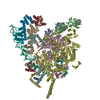+Search query
-Structure paper
| Title | Structural and functional characterization of AfsR, an SARP family transcriptional activator of antibiotic biosynthesis in Streptomyces. |
|---|---|
| Journal, issue, pages | PLoS Biol, Vol. 22, Issue 3, Page e3002528, Year 2024 |
| Publish date | Mar 1, 2024 |
 Authors Authors | Yiqun Wang / Xu Yang / Feng Yu / Zixin Deng / Shuangjun Lin / Jianting Zheng /  |
| PubMed Abstract | Streptomyces antibiotic regulatory proteins (SARPs) are widely distributed activators of antibiotic biosynthesis. Streptomyces coelicolor AfsR is an SARP regulator with an additional nucleotide- ...Streptomyces antibiotic regulatory proteins (SARPs) are widely distributed activators of antibiotic biosynthesis. Streptomyces coelicolor AfsR is an SARP regulator with an additional nucleotide-binding oligomerization domain (NOD) and a tetratricopeptide repeat (TPR) domain. Here, we present cryo-electron microscopy (cryo-EM) structures and in vitro assays to demonstrate how the SARP domain activates transcription and how it is modulated by NOD and TPR domains. The structures of transcription initiation complexes (TICs) show that the SARP domain forms a side-by-side dimer to simultaneously engage the afs box overlapping the -35 element and the σHrdB region 4 (R4), resembling a sigma adaptation mechanism. The SARP extensively interacts with the subunits of the RNA polymerase (RNAP) core enzyme including the β-flap tip helix (FTH), the β' zinc-binding domain (ZBD), and the highly flexible C-terminal domain of the α subunit (αCTD). Transcription assays of full-length AfsR and truncated proteins reveal the inhibitory effect of NOD and TPR on SARP transcription activation, which can be eliminated by ATP binding. In vitro phosphorylation hardly affects transcription activation of AfsR, but counteracts the disinhibition of ATP binding. Overall, our results present a detailed molecular view of how AfsR serves to activate transcription. |
 External links External links |  PLoS Biol / PLoS Biol /  PubMed:38427710 / PubMed:38427710 /  PubMed Central PubMed Central |
| Methods | EM (single particle) |
| Resolution | 3.35 - 5.1 Å |
| Structure data |  EMDB-35046: Focused map on the aCTD-AfsR-DNA region of the Streptomyces coelicolor AfsR-dependent transcription activation complex EMDB-35047, PDB-8hvr:  EMDB-36369: Focused map on the aCTD-AfsR(T337A) region of the Streptomyces coelicolor RNAP-promoter open complex with AfsR(T337A) dimer EMDB-36370, PDB-8jke: |
| Chemicals |  ChemComp-MG:  ChemComp-ZN: |
| Source |
|
 Keywords Keywords |  GENE REGULATION / GENE REGULATION /  RNA polymerase / SARP regulator / RNA polymerase / SARP regulator /  TRANSCRIPTION / GENE REGULATION/DNA / GENE REGULATION-DNA complex TRANSCRIPTION / GENE REGULATION/DNA / GENE REGULATION-DNA complex |
 Movie
Movie Controller
Controller Structure viewers
Structure viewers About Yorodumi Papers
About Yorodumi Papers








